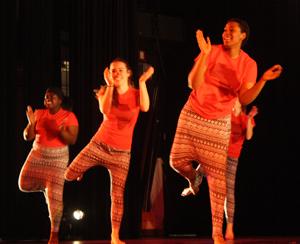Cultural sharing fights ignorance and appropriation

Senior Dakessa Hector, junior Alicia Bierauer, and sophomore Fanta Diallo perform in a West African dance piece choreographed by Kenna Camara Cottman. Cotman believes that sharing of cultural traditions promotes cultural understanding and acceptance.
June 4, 2014
“The history that we learn in school is completely whitewashed – meaning that the stories of non-white cultures are minimized, erased, diminished and ignored,” wrote dance instructor Kenna Camara Cottman in an email. “The perspective of Blackness needs to be inserted and presented, by Black people, to provide a more accurate history. This is one reason I share and teach in white-dominated, mainstream institutions like schools and universities.”
“Appropriation is when members of the dominant culture (white) start to pick and choose different aspects of non-white cultures that they are interested in, using their privilege and access to resources in order to learn the thing that they want to learn, take the trip and study the people that they want to study,” explained Cottman. Recently, stories of pop artists guilty of cultural appropriation have been all over the news and social media. Katy Perry’s ‘geisha inspired’ performance at the AMAs, her ‘Egyptian themed’ music video for “Dark Horse,” Avril Lavigne’s use of Japanese culture in her “Hello Kitty” video, and Lana Del Rey and Gwen Stefani both sporting Native headdresses in music videos, are only a few examples.
However, cultural appropriation can also be found closer to home.
Cottman teaches West African dance and hip hop as a professor at the University of Minnesota, and as the director of her dance company, Voice of Culture. In her teaching, she wrote, she has had many encounters with cultural appropriation.
“I once taught Lamba, a dance from the old Mali empire that honors the griots and oral histories, to a group of 5th graders at school I was a teacher at. We performed the dance for a school assembly and also for a community celebration. I sewed the lappas and shirts and played the drums for the students. The next thing I knew, the music teacher had taught a different group of students an ‘African dance’ and gave them some cloth to tie around their waists. My group was not asked to do the next assembly and we were all confused. We had been appropriated.”
Dance is not the only area of art where cultural appropriation is rampant. The fashion industry has recently been under criticism for appropriating cultural objects in many runway shows. One common example is the use of American Indian headdresses.
“Generally the headdress is only worn for ceremonial or spiritual purposes,” said Kasey Keeler, Graduate Instructor of American Indian studies at the University of Minnesota. “It’s not something that’s worn on a day to day basis. It’s reserved for those people in a leadership position.”
“I don’t know why people wear them,” expanded All Nations sophomore
. “I think they mainly wear them out of ignorance…they just don’t know the significance of it, they think it’s something you can just wear for fashion.”
“For the Victoria’s Secret fashion show, when you’re walking around, practically naked, wearing this item that’s very significant for a lot of Indian cultures, that’s hugely offensive,” Keeler said.
Headdresses were also wildly popular at the music festival Coachella, where they were worn as fashion statements. Many people, predominantly white women, wear them without understanding their cultural significance. However, Kier-Ficken explained, “[Headdresses are] really for men.”
According to Cottman, cultural sharing is an important way to prevent cultural appropriation. “Sharing is when one gives willingly, with a welcoming and open spirit. A recipient of shared culture tries to understand the culture as it is, without translating,” she explained.
Cottman taught a West African dance unit in South’s dance department this winter. She taught traditional dance, while also teaching students about the meaning of the dances, where they come from, and the cultural groups they are specific to. Cultural sharing, like Cottman teaches, allows for people who do not belong to a certain culture to appreciate cultural elements without appropriating. For the dance company, this unit culminated in a dance piece that Cottman choreographed and they performed in their Spring Showcase. The company performed a West African fusion piece, with modern costumes and Cottman’s modern twist.
According to Keeler and Kier-Ficken, educating people about different cultures is especially important to combating ignorance.
“How would you feel if a person was wearing a super skimpy bikini with, for example, Bibles on it?” Keeler asked. “These kinds of things would be offensive to a lot of people. People who often do this kind of cultural appropriation often see it through their own set of eyes, and don’t care about the history or the culture behind it. Because if they truly did, they would be learning about it, and learning that what they are doing is truly offensive.”
“I am concerned about [cultural appropriation], that’s why I teach the way that I do,” Cottman said. “I teach the cultural context along with the dance movements in hopes that people will realize that there is much more to West African Dance than what you might be able to figure out by watching a performance. This art form is a blend of culture and technique.”
“My hope is that students who are not of African descent will start to think about African dance in cultural ways,” she added. “And students who are of African descent will start to think about African dance in technical ways.”





